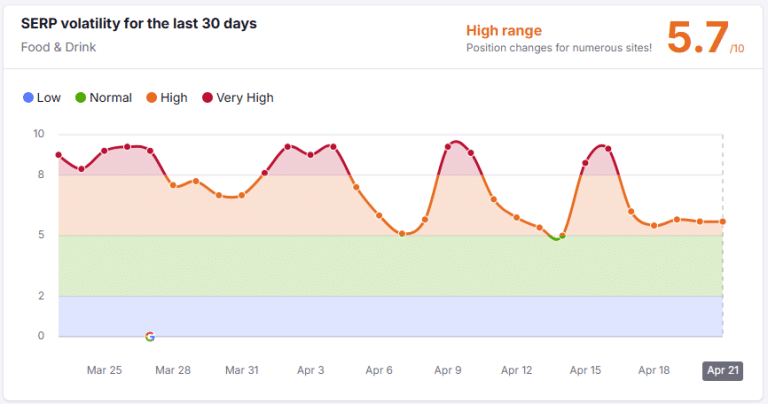Search Engine Results Page (or SERP) volatility refers to a measurement that quantifies the level of short-term changes in search engine rankings for a group of search queries, typically either for Google as a whole, or a given industry, that occur over a timescale of days to weeks.
High volatility can have direct impacts on business metrics.
Reuters reported that reddit recently experienced “volatility with Google search triggered by a periodic algorithm change [that] impacted logged-out users… growth slowed sequentially”.
In another example, Search Engine Land reported that the Food and Drink industry experienced 54% more volatility in 2024 compared to 2023 according to Semrush Sensor’s volatility tool –which is important to be aware of if your restaurant business relies on local search.
Losses in rankings, website visibility and organic traffic translate directly into losses in revenue. However, positioning yourself to succeed in SEO can also prepare you to benefit from volatility.
In this article, we’ll aim to explain:
- what SERP volatility is
- why its measurement is interesting yet controversial
- and how you can protect your business from volatility, or even benefit from it

What Causes SERP Volatility?
A non-exhaustive list of the causes of SERP volatility includes the following:
Algorithm Updates
Updates to the Google search algorithm can impact rankings and may also alter the occurrence of special features (e.g. AI Overviews and MapPack) that appear in a SERP.
Changes in User Intent
Trends in search queries may reflect an underlying change in the meaning of a given search query.
For example, searching for a character from a TV show will acquire new meaning and context after the show begins and as it progresses. Searches that reflect evolving themes (e.g. sports team, celebrities, internet memes) are likewise subject to changing intents.
Seasonal Trends
Holidays, for example, are related to spending and travel patterns, and so proximity to them will correlate to an increased number of results with transactional intent. Searching for information on taxes, donations, weather patterns (e.g. hurricanes), and political candidates also exhibit seasonality which can lead to volatility.
Competitor Actions
Organizations that regularly create fresh, market-relevant content typically see search ranking improvements. Some organizations may even advertise on their competitor’s keywords, which can directly impact your bottom line.
How to Measure and Monitor SERP Volatility
Challenges in Measuring Volatility
Although the concept of volatility as a measure of change is agreed upon, most of the methods to calculate the volatility by the leading proponents of these measures are proprietary. We can surmise that they differ in their details since they produce volatility curves with different qualitative characteristics.
Tools to Track SERP Volatility
Proprietary algorithms have been developed by Semrush, MozCast, RankRanger, and others.
Interestingly, we have found only one example, Accuranker, that publishes its method of volatility calculation.
Of note, Wireboard provides a Meta-SERP volatility index which aggregates the results of volatility measurements from the above sources at the level of the entire Google search.
A few of these tools display SERP volatilities at the level of an industry instead of across all of Google search (including Semrush, Advanced Web Ranking, and DataForSEO). However, inspection shows that there are qualitative differences even in the shapes of the volatility curves at the level of industries.
When the outputs of these algorithms are qualitatively different, it is not clear why they are different – leading to a sense of confusion and loss of trust.
Examples of Volatility Measurement
Let’s provide an example of measuring SERP volatility. If math is your thing, welcome fellow nerd. Click below to get in the weeds with us.
Not so into the math? No worries, just keep on scrolling.
See The Math!
The Math
Accuranker’s Google Grump algorithm measures 30,000 randomly selected keywords every day, and reports the sum of the total change in ranking positions for all pages that rank in the top 100 between consecutive days as the Grump Rating. Although this is a perfectly reasonable definition of volatility, we will now embark on a quite different definition of volatility as an exercise to illustrate several points about defining volatility.
In our new definition of volatility, we will make a substitution: replacing the rankings by the likely fraction of traffic the page at that rank draws. Second, we’ll calculate the weighted average of volatility for a group of search queries (which we’ll call an index), using the search volume for each query as the weight.
For the first modification, we’ll assume for simplicity that the traffic is normalized such that the top 10 links add to 100% of the traffic. For the “likely traffic” we can use the statistics reported by this study from backlinko. Normalizing the top 10 results such that they add to 100% provides us with the following table:
Rank | Percent Traffic |
1 | 32.0% |
2 | 18.3% |
3 | 12.8% |
4 | 9.7% |
5 | 7.3% |
6 | 5.7% |
7 | 4.5% |
8 | 3.8% |
9 | 3.1% |
10 | 2.8% |
We may then define volatility for an individual search query as the absolute magnitude of the change in likely organic traffic taken over a series of equally-spaced-in-time measurements of the SERP, divided by the number of measurements of the SERP less one:
Vp,m = (∑∑|Ti-Tj|)/(m-1)
where the inner sum is taken over all pages in the SERP in subsequent measurements, the outer sum is taken over pairs of subsequent measurements, the T are the likely organic traffic values presented in the table above, and m is the number of measurements of the SERP. To be meaningful and comparable, these volatility measurements should be reported along with the period over which they are measured (p), and how many measurements were taken (m). For example, if the SERP is measured on three subsequent days for each calculation, we could denote the volatility as Vd,3 where the d denotes days. Volatility measurements taken over six weeks may be denoted as Vw,6.
Let’s look at examples.
Keyword-level: Example #1
Suppose that on two subsequent days, we obtain a SERP in which the only change is that the pages at rank #1 and rank #2 swap. The volatility should then indicate twice the change in traffic from rank #1 to rank #2, because one site gained that much traffic, and one site lost that much traffic.
Thus, the daily volatility Vd,2 is equal to 2*(32-18.3)/(1) = 27.4.
Keyword-level: Example #2
In another example, the maximum possible change between any two measurements of the SERP occurs when the entire first-page SERP is replaced with a fresh set of pages.
In this case, the volatility is 200, since that is the total page-wise change in traffic flow (positions #11 and beyond have zero weight, and there are two measurements hence the sum is 200).
Industry-level Thoughts
However, we have so far focused only on volatility at the query level. What is often more interesting is the volatility of an index of common search terms in an industry. To arrive at index-level volatility, we could then weighted average over the query volatilities for a group of queries that are meaningful to that industry. The weights used for the weighted average may be the search volume for that search query (or alternatively to place greater emphasis on smaller volume queries, the logarithm thereof).
Takeaways
From this toy example of defining our own volatility measurement, we have demonstrated several aspects of volatility.
- First, definitions matter. In our formulation of volatility, rank changes in positions #1-5 will result in much more volatility than those in ranks #6-10; also rank changes that are confined to positions #11 and beyond would not impact volatility in this example, whereas in the Grump calculation, changes in rank of equal magnitude at positions beyond #10 would be equally important as those at high rank.
- Secondly, the frequency of measurement of rank matters, as does the number of measurements considered –as additional measurements will produce a moving average calculation. The proprietary volatility tools mentioned above operate using volatilities that consider measurements on two subsequent days only (or claim to measure the rankings continuously). Still, it would be interesting to look into whether the volatilities calculated with additional measurements (e.g. moving averages calculated over a period of subsequent days) more effectively demonstrate seasonal trends in volatility. Notably, the default window of focus for most of the volatility tools mentioned above is only a few weeks; studying longer-term changes in volatility and year-over-year changes would be another area for exploration.
- Third, we don’t know what additional parameters may be involved in these volatility calculations; none of them explicitly rule out applying different weights to different ranks or using search volume to weight search queries in the index volatilities (for example). Additional factors that affect volatility algorithms which we have not discussed in this example include the choice of keywords being tracked, the locations (UULEs) used for the searches that obtain rank, and the choice to record rank for desktop or mobile search.
How Does SERP Volatility Impact SEO and Website Traffic?
OK – back from the math (and for those of you who were brave enough to dig into that, welcome back).
What does all of this mean for your marketing efforts?
Effects on Organic Traffic
The biggest impact ranking fluctuations and SERP volatility can have on your business is the one you’re likely already aware of: impacting your website traffic. SERP volatility – shifting rankings, new ranking websites, etc. – can cause your website to move in search results and directly impact how many visitors reach your website.
By understanding SERP volatility – and how to combat it – you can help minimize (and even capitalize!) the impact it has on your website performance.
Opportunities from Volatility
While SERP volatility can be scary, it can also be a strong opportunity.
Math helps us understand the “when” and the “to what degree” – but our “marketing” brains can help us identify the “why.
If we’re able to understand why volatility is happening within a keyword or at an industry-level, we can adjust our strategy to ensure we’re creating a strategy that’s ready for the fluctuations.
Strategies to Manage and Adapt to SERP Volatility
Focus on Content Quality and Relevance
Pages stand out when content is original, has both breadth and depth relevant to different user intents (which also satisfies targeting multiple keywords and long-tail variants), is timely, and makes clever use of multimedia to design immersive experiences for the end user. Creating evergreen content is another strategy in an SEO’s toolkit.
Diversify Keyword Strategy
Using a financial analogy, if diversifying your stock portfolio is the best way to make your investment resistant to volatility in the market, then diversifying your keyword portfolio is a tool to protect your search rankings against search engine volatility.
In other words – don’t let one singular keyword (or a group of keywords) make or break your whole strategy.
At FourFront, we work on improving your keyword rankings – but we also focus on growing the quantity of ranking keywords over time.

Maintain Flexibility in SEO Approach
Being open to adapting your SEO strategy is key to maintaining a competitive edge.
Modern SEO must account for the user intent, the on-page user experience, seasonal trends, competitor strategy (such as when a competitor is buying your keywords), and changing market conditions – these are things that SEO companies excel in.
User behaviors aren’t the only things changing. Google’s search results are always evolving. One prominent example: AI Overviews are creating a seismic shift in the way users interact with search engines. Companies like FourFront can monitor the appearance and rate of occurrence of AI Overviews in SERPs and adjust keyword strategy accordingly.
Navigating SERP Volatility
In summary, understanding the ways to protect your website against sudden and drastic changes to search engine results caused by the aforementioned factors is critical to success in search engine optimization.
The benefit of volatility is that it can give new sites an opportunity to rise in the rankings. Regularly monitoring rankings using tools such as Semrush, RankRanger, Advanced Web Ranking, DataForSEO, etc. is recommended. Being proactive about publishing good content and optimizing it for your audience is also critical and SEO services like those offered at FourFront can help in this capacity.
Unfortunately, many businesses are unable to measure SERPs for common search queries in their industry on a regular basis. And it’s daunting! There is a lot to monitor and track.
Need help tracking keywords for your business and industry? Let’s talk.









